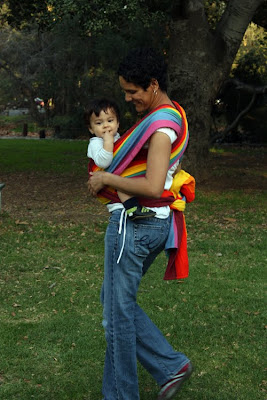As soon as the blue line appears on a pregnancy test, many women go to great lengths to keep the fetus growing in our wombs healthy. We may stop drinking diet soda, or stop eating sushi. Some of us quit smoking. We sleep in a position that provides the best blood supply to the placenta, we go to the doctor or midwife frequently for check ups, we ask our husbands to scoop the litter box for the duration.
We also spend time making sure that our babies stay healthy after the birth. We interview pediatricians. We read about breastfeeding, kangaroo care, circumcision, vaccines and babywearing. We childproof the house and make sure all our gear meets current safety standards. We ask visitors to wash their hands.
After birthing a baby though, how many mothers pay as close attention to their own health as they did during pregnancy? How many of us quickly slide back into our bad habits of staying up too late, exercising too little, or drinking way too much coffee? How many of us put our physical health at the bottom of the priority list?
To be fair, it’s not always easy to be healthy. If you had a difficult delivery, convenience can trump healthfulness. When you’re sleep deprived, it’s hard to make the best choices. When you have other children to care for and a To-Do list a mile long, or if you’re juggling responsibilities at work with duties at home, it’s way too easy to let yourself slide to the bottom of the pile.
The problem is, it’s so important to take care of yourself after you have a baby, so you can heal, so you can be the healthiest mom you can be.
Here are 5 ideas to consider if you’re expecting, to make it easier to take care of yourself after your baby is born.
- Take up yoga–Yoga is great because it can be done at so many levels. A beginner can benefit just as much as a guru who has been practicing for years. Most poses can be modified to your skill level, and because yoga is low impact, it’s a great way to ease a postpartum body back into exercise while sparing your joints and stretched out abs. You can tailor your practice to your needs and in the privacy of your own home if you’re shy. Check out Yoga Journal for poses, tons of info, and podcasts, and join Yoga Today for access to a free weekly class.
- Freeze your dinners–Before my second child was born, I spent several days in the kitchen, cooking meals that could be frozen, such as Greek Spinach Pie, Lasagna Roll Ups, chili, soups and more. Having the freezer packed with wholesome, homemade food not only meant I was eating well after delivery, but it also made cooking dinner a lot easier. Simply thaw the meal and heat it up. This was one of the biggest things that saved my sanity because my husband went back to work after a week, and my baby took a long time to figure out the difference between night and day. At home alone with a newborn and a 2 year old, and up most of the night with the baby, I was absolutely exhausted. Knowing that we had something to eat for dinner was a huge weight off my mind.
- Order your groceries online–Most of the large chains of grocers offer this service. There are pros and cons to it (you can be very specific about your produce, and your personal shopper collects your order and bags it, but you can’t usually use coupons and fuel and delivery charges may apply), but if you’re busy trying to establish breastfeeding, or limited physically because of a c-section, having your groceries delivered can be a huge help. Plus, you can shop online at 2AM in your jammies if you want! Personally, I also found that it helped me eat healthier because I stayed out of the junk aisles.
- Fit exercise into everyday activities–Who has the time or energy to spend an hour on the elliptical when you have a new baby at home? Rather than writing off exercise altogether, try splitting it into smaller doses. Studies have shown that ten minutes of exercise three times a day is just as effective as thirty minutes at once. Do toe raises while folding laundry, push ups during commercials, or spend a few minutes stretching before bed. It adds up.
- Identify your stress causers and then streamline to avoid them–Sleep when the baby sleeps is a great piece of advice, but it’s not always practical. Figure out what you’re okay with letting slide, and what absolutely needs to be done, then find a way to make it happen. For me, I’m pretty particular about the cleanliness of my house. Letting the laundry pile up or not vacuuming for weeks was just not an option because of the stress it would cause me. So before my baby was born, I spent a couple of days deep cleaning each room, so the house was nice and clean when we came home from the hospital. Afterward, I tried to stick to a rough cleaning schedule so all the usual chores were split up throughout the week. Changing the cat box on Sunday, bathroom on Monday, dusting on Tuesday, etc. My house stayed looking relatively neat, and I could rest easy knowing I didn’t have a huge mess to deal with when I did get a chance to take a nap.
What about you? What advice do you have to stay healthy while recovering from childbirth and caring for a new baby?


 questions and more become so much clearer once you know the basic carrier types. There are six basic types of carriers. They are woven wraps, stretchy wraps, ring slings, pouches, mei tais and buckle carriers.
questions and more become so much clearer once you know the basic carrier types. There are six basic types of carriers. They are woven wraps, stretchy wraps, ring slings, pouches, mei tais and buckle carriers.

 Let’s be honest: toddlers and young preschoolers can wear on even the most patient person’s nerves. From the constant questions (“why?” “wat dat?” “where mama go?”) to the wild mood swings and outbursts,
Let’s be honest: toddlers and young preschoolers can wear on even the most patient person’s nerves. From the constant questions (“why?” “wat dat?” “where mama go?”) to the wild mood swings and outbursts,